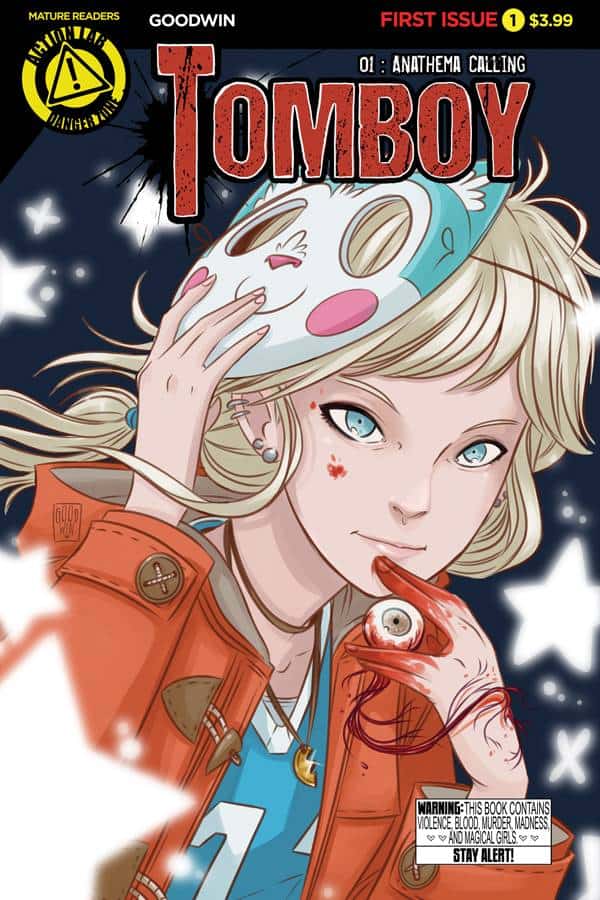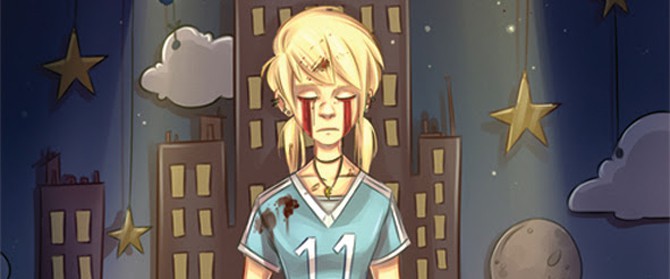
Written and drawn by Mia Goodwin
Published by Action Lab (Danger Zone)
There is a real glut of Magical Girl (and Magical Girl inspired) comics starting to come out from a variety of publishers, including Zodiac Starforce, Power Up, and even Babs Tarr’s work on Batgirl. However, Mia Goodwin’s Tomboy #1 stands out from these other titles by combining the bright cheerfulness of the Magical Girl genre with the pain of losing a best friend as well as the vigilante genre with a touch of a police procedural. It is influenced by the recent 2011 Magical Girl anime Madoka Magica, which looks at the dark cost of being a magical girl and isn’t all fun, games, and transformation sequences. It is fitting that the comic opens with introspective voice-over narration, a bleak blue color palette, and its protagonist, hockey player and Magical Girl enthusiast, Addison covered in blood.
Before the blood spills and the transformations happen, Tomboy #1 begins by building the sometimes sweet, sometimes sour relationship between Addison, her retired police chief grandpa, and her father Mark, who is a medical examiner for the police department. Grandpa reads like a late Clint Eastwood role (Think Gran Torino with less racism.) as he critiques the softness of the Rivergrove PD with such pulpy dialogue like “Back when I was chief, you either put em in bars or in the ground”. Mark is more into things like due process and making pumpkin pancakes for Addison’s 16th birthday, and his optimism is a nice foil to Grandpa’s blunt realism. And caught in the middle is Addison, who is a carefree teenager obsessed with the Princess Cheery Cheery cartoon and her boyfriend/best friend Nick. However, her whole life doesn’t revolve around them, and Goodwin includes an extended, banter-filled conversation between her and her friend Jessica, who has fabulous hair before things get dark and sad.
Even if Tomboy #1 is set in a stylized world of corrupt cops and violent teenage girls with magical abilities, Mia  Goodwin deals with the grieving process in an emotionally honest and realistic manner through her art, dialogue, and letters. For example, Mark gets called away to ID a body in the river and begins with his typical words about an unidentified corpse before he realizes that it’s his godson and his daughter’s boyfriend Nick as his phone drops, and his face seizes up in sadness. A similar thing happens to Addison when she overhears her hockey coach on the phone with the police about Nick’s death in a silent scene where she collapses on the floor gripping her hockey stick. Her caption boxes are pitch black and filled with denial, the first stage of grief. The combination of image, text, lettering technique, and cold colors creates an atmosphere of sadness for readers.
Goodwin deals with the grieving process in an emotionally honest and realistic manner through her art, dialogue, and letters. For example, Mark gets called away to ID a body in the river and begins with his typical words about an unidentified corpse before he realizes that it’s his godson and his daughter’s boyfriend Nick as his phone drops, and his face seizes up in sadness. A similar thing happens to Addison when she overhears her hockey coach on the phone with the police about Nick’s death in a silent scene where she collapses on the floor gripping her hockey stick. Her caption boxes are pitch black and filled with denial, the first stage of grief. The combination of image, text, lettering technique, and cold colors creates an atmosphere of sadness for readers.
And Mia Goodwin’s lettering is an integral part of Tomboy #1’s storytelling from the beginning of the story when she puts a bubble in another bubble’s tail to show the interruption heavy nature of Addison and her grandpa’s conversations as he’s going on about football games (Soccer because the comic is set in England) while she sings the Princess Cheery Cheery theme song. Later, she brings out the black word bubbles, which represent Addison’s sadness and thoughts of vengeance before combining with her fantasies about Nick to turn her into a rage-filled magical girl. The words in the black bubbles are blurred because she is struggling to come to terms with the death of the boy she loved, especially when she sees a couple of police officers openly talking and bragging about killing Nick and dangling the other half of their friendship necklace.
Tomboy #1 is a cleverly plotted book as well with the opening breakfast conversation between Addison, Grandpa, and Mark paying off later in the issue and down the road. Even though the comic opens up with Addison talking about her closeness with her dad, who used to check her bed for monsters and is throwing her a birthday party, she immediately goes to her grandpa after killing the police officers on the train. Perhaps his more Dirty Harry conception of justice and hatred of the Trent Pharmaceutical company that employed the cops will make him sympathetic towards her actions than her by-the-book father. Addison’s family dynamic and their different ideas about law and order add another layer of conflict in the comic.
Tomboy #1 successfully combines the Magical Girl and vigilante genres through Mia Goodwin’s art with manga-style figures to go with the grisly images of dead bodies and spattered gore and mix of bright and cold colors depending on the mood of the scene. Goodwin also builds the characters of Addison, her dad and granddad before unleashing hell with not one, but two murders of people close to them. With her authentic handling of the grieving process and the effects of violence, Mia Goodwin shows that there is room for earned darkness in Magical Girl stories in Tomboy #1.


